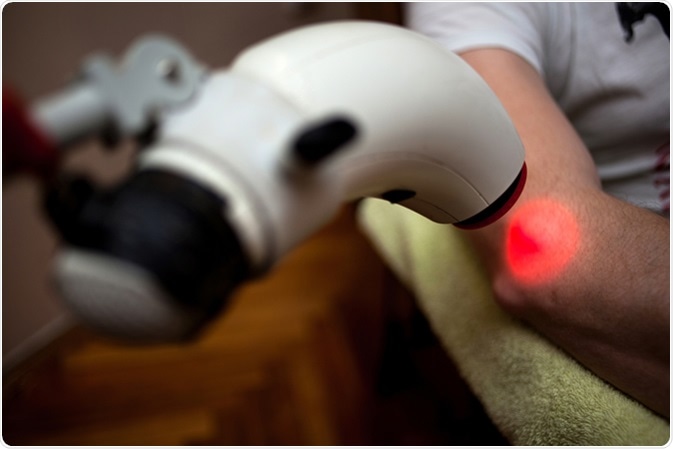Infrared therapy is a new and innovative light-based method to treat pain and inflammation in various parts of the body. Unlike ultraviolet light, which can damage the skin, infrared light enhances cell regeneration. Infrared light is delivered to the site of injury or inflammation at certain wavelengths, promoting cell repair.
The key characteristic of infrared light is its ability to penetrate even the deep layers of the skin, providing better pain relief. Also, infrared light is safe, natural, non-invasive, and painless. Thus it may be able to provide a broad range of health benefits.

Infrared treatment for rehabilitation orthopedic medical care. Image Credit: VP Photo Studio / Shutterstock
Why is Infrared Therapy Widely Used Today?
Infrared therapy is widely used in the fields of medicine, dentistry, veterinary medicine, and in autoimmune diseases, to name a few. The therapy is safe and natural, which enables it to be offered as an alternative treatment for various health conditions like muscle pain, joint stiffness, and arthritis, to name a few.
Infrared therapy has many roles in the human body. These include detoxification, pain relief, reduction of muscle tension, relaxation, improved circulation, weight loss, skin purification, lowered side effects of diabetes, boosting of the immune system and lowering of blood pressure.
What are the Health Benefits of Infrared Therapy?
Cardiovascular Health
One of the key health benefits of infrared therapy is improvement in cardiovascular health. Infrared light increases the production of nitric oxide, a vital signaling molecule that is important for the health of blood vessels. This molecule helps relax the arteries and prevents blood from clotting and clumping in the vessels. Aside from these, it also combats free radicals to prevent oxidative stress and regulate blood pressure.
Nitric oxide is essential in improving blood circulation, which provides more oxygen and nutrients to injured tissues. Thus, infrared light hastens wound healing and stimulates the regeneration of injured tissues, reducing inflammation and pain.
Pain and Inflammation
Infrared therapy is an effective and safe remedy for pain and inflammation. It can penetrate deep through the layers of the skin, to the muscles and bones. Since infrared therapy enhances and improves circulation in the skin and other parts of the body, it can bring oxygen and nutrients to injured tissues, promoting healing. It helps ease pain, relieve inflammation, and protect against oxidative stress.
Muscular Injuries
Infrared therapy improves the action of the mitochondria within cells, thus triggering the growth and repair of new muscles cells and tissues. In other words, infrared light can hasten the repair process after a muscle injury.
Detoxification
Infrared therapy can be applied through saunas. Detoxifications are important since they may strengthen the immune system. At the same time, detoxification aid biochemical processes to function properly, improving food digestion. In infrared saunas, the body’s core temperature increases, leading to detoxification at the cellular level.
Potential Cancer Cure
Infrared therapy is a potentially viable cancer treatment. Studies show significant activation of nanoparticles when they are exposed to infrared radiation, rendering them highly toxic to surrounding cancer cells. One such modality is photoimmunotherapy, using a conjugated antibody- photoabsorber complex that binds to cancer cells.
Killing Cancer Cells with the Help of Infrared Light - Photoimmunotherapy
What are the Risks Linked to Infrared Therapy?
Each day, humans are immersed in infrared radiation from the sun in the form of heat. In fact, infrared saunas are in-demand today, but experts warn of possible health risks. Thermal or heat injuries can happen, depending on the wavelength of the infrared light. Thermal injury can occur even without pain. Also, pregnant women, people with heart diseases, and those who are sick should never undergo infrared therapy.
Moreover, experts warn against using infrared therapy to treat chronic diseases while neglecting the use of medications and recommended treatment procedures. Though infrared therapy promises many health benefits, its study is far from complete. At present, therefore, it should be considered an adjunct to medical treatment, and other regimens should be continued as prescribed.
Further Reading